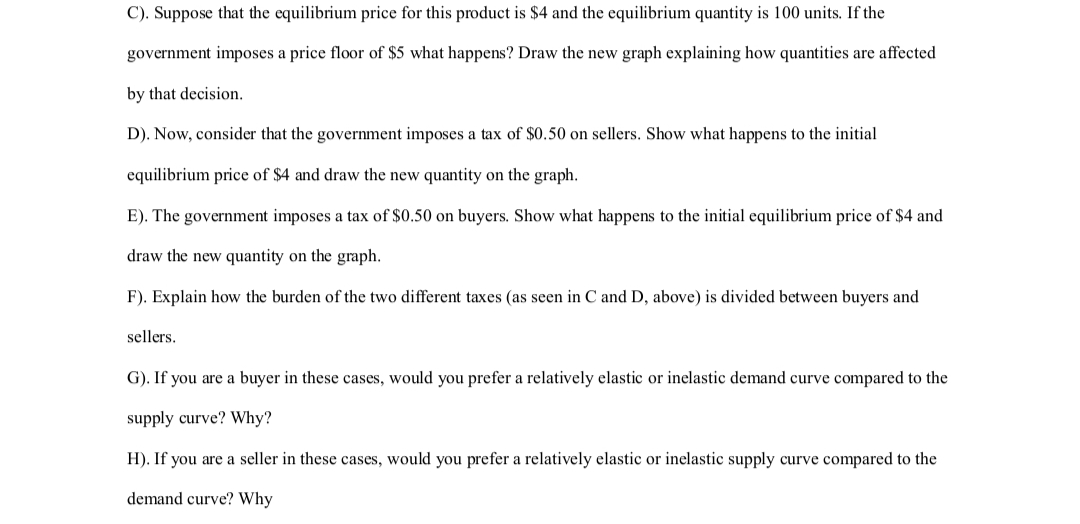C). Suppose that the equilibrium price for this product is $4 and the equilibrium quantity is 100 units. If the government imposes a price floor of $5 what happens? Draw the new graph explaining how quantities are affected by that decision.
C). Suppose that the equilibrium price for this product is $4 and the equilibrium quantity is 100 units. If the government imposes a price floor of $5 what happens? Draw the new graph explaining how quantities are affected by that decision.
Principles of Macroeconomics (MindTap Course List)
8th Edition
ISBN:9781305971509
Author:N. Gregory Mankiw
Publisher:N. Gregory Mankiw
Chapter6: Supply, Demand, And Government Policies
Section: Chapter Questions
Problem 10PA
Related questions
Question

Transcribed Image Text:C). Suppose that the equilibrium price for this product is $4 and the equilibrium quantity is 100 units. If the
government imposes a price floor of $5 what happens? Draw the new graph explaining how quantities are affected
by that decision.
D). Now, consider that the government imposes a tax of $0.50 on sellers. Show what happens to the initial
equilibrium price of $4 and draw the new quantity on the graph.
E). The government imposes a tax of $0.50 on buyers. Show what happens to the initial equilibrium price of $4 and
draw the new quantity on the graph.
F). Explain how the burden of the two different taxes (as seen in C and D, above) is divided between buyers and
sellers.
G). If you are a buyer in these cases, would you prefer a relatively elastic or inelastic demand curve compared to the
supply curve? Why?
H). If you are a seller in these cases, would you prefer a relatively elastic or inelastic supply curve compared to the
demand curve? Why
Expert Solution
This question has been solved!
Explore an expertly crafted, step-by-step solution for a thorough understanding of key concepts.
This is a popular solution!
Trending now
This is a popular solution!
Step by step
Solved in 2 steps with 1 images

Knowledge Booster
Learn more about
Need a deep-dive on the concept behind this application? Look no further. Learn more about this topic, economics and related others by exploring similar questions and additional content below.Recommended textbooks for you

Principles of Macroeconomics (MindTap Course List)
Economics
ISBN:
9781305971509
Author:
N. Gregory Mankiw
Publisher:
Cengage Learning

Essentials of Economics (MindTap Course List)
Economics
ISBN:
9781337091992
Author:
N. Gregory Mankiw
Publisher:
Cengage Learning

Principles of Economics (MindTap Course List)
Economics
ISBN:
9781305585126
Author:
N. Gregory Mankiw
Publisher:
Cengage Learning

Principles of Macroeconomics (MindTap Course List)
Economics
ISBN:
9781305971509
Author:
N. Gregory Mankiw
Publisher:
Cengage Learning

Essentials of Economics (MindTap Course List)
Economics
ISBN:
9781337091992
Author:
N. Gregory Mankiw
Publisher:
Cengage Learning

Principles of Economics (MindTap Course List)
Economics
ISBN:
9781305585126
Author:
N. Gregory Mankiw
Publisher:
Cengage Learning

Principles of Microeconomics (MindTap Course List)
Economics
ISBN:
9781305971493
Author:
N. Gregory Mankiw
Publisher:
Cengage Learning

Principles of Macroeconomics (MindTap Course List)
Economics
ISBN:
9781285165912
Author:
N. Gregory Mankiw
Publisher:
Cengage Learning

Principles of Economics, 7th Edition (MindTap Cou…
Economics
ISBN:
9781285165875
Author:
N. Gregory Mankiw
Publisher:
Cengage Learning